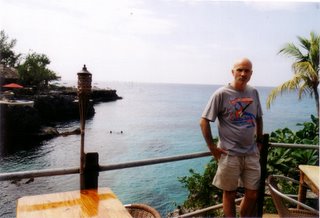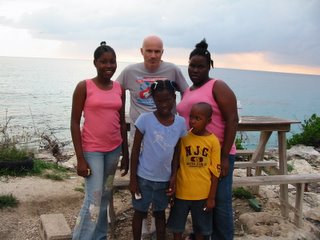
Read here for part one of Jamaica, Yo Problem.
Also posted on Pajamas Media.
When we decided to travel to Jamaica for a vacation, my family and I decided not to stay in one of the increasingly popular "all-inclusive" resorts, instead we selected the Wexford Court Hotel in the middle of Montego's Bay "Hip Strip."
In that spirit of immersing ourselves in Jamaica, as opposed to walling ourselves in an all-inclusive property, we decided to rent a car and travel outside of Montego Bay, or "Mobay," as the locals sometimes refer to it.
One of my goals of this series, as I stated in my earlier Jamaica post, is to ignite travel blogging--in short do to that travel journalism what poli-blogging has done to mainstream political writing. Travel writing, such as what is found in most daily newspapers, is a sycophantic exercise designed to benefit the hospitality industry.
The car we rented a Toyota Yaris sedan. As with most former British colonies, drivers use the left side of the road, not the right.
I was a bit tense about having to change my driving pattern--I've been driving on the right side of the road, uninterrupted, for 17 years. It'd soon become clear that'd be the least of my worries regarding my two days on the roads of Jamaica.
Negril was our destination for our first day. I drove for about a half mile before I had a close call behind the wheel, as I drove over a massive pothole at full speed. Luckily, no damage was done to the car. In part one of Jamaica, Yo Problem, I wrote about the deplorable conditions of the sidewalks in Montego Bay. The roads in Jamaica are equally awful, they're narrow and filled with potholes.
I asked Morris, a cab driver who drove us to the Half Moon resort on our first full day in Jamaica, about the bad roads. "Why aren't the potholes fixed?" He told me, "The crews are too busy building the North Coast Highway to Ocho Rios." I'm getting a head of myself, because that's where we're headed on the second day of our Jamaican road trip.
Once we got out of Montego Bay, the roads widened and I was almost comfortable driving. Still, I had to be constantly on the look-out for potholes.

The roadsides are pleasantly populated by stands such as this one, where I purchased some mangoes.
Towns were a problem. The roads contract inside villages, the streets in these towns haven't had been widened, in all likelihood, since the horse-and-buggy days. In Lucea, halfway to Negril, on a very tight portion of a street, I sideswiped a high curb that seemingly came out of nowhere. Luckily, the plastic bumper that met the concrete was already scratched on my rental car. A previous driver of the car probably did the same thing I did.
I elected to get full insurance coverage on the Toyota. It cost an extra $50. Just for the peace-of-mind it gave me it was worth it.
Yes, the roads are bad, but the drivers aren't much better. My wife asked me why I was using my lane change signal-- because no one else was. Jamaican drivers like to nudge toward the center of the road, expecting the oncoming vehicle to back off---which is how I ended up hitting the curb in Lucea. As I gained more experience driving in Jamaica, I learned to do the same thing--hold the center of the road--while looking out for potholes.
Negril is unique in Jamaica. From our guidebook, Frommers' Jamaica:
On the arid tip of Jamaica, Negril has had a reputation for bacchinalia, hedonism, marijuana smoking, and nude sunbathing, since hippies discovered its sunny shores in the 1960s. The resort became more mainstream during the 1990s as big-money capitalists built megaresorts, most of them managed by SuperClubs or Sandals. Yet some resorts still reserve stretches of beach for nude bathers, and illegal ganja is still peddled openly.
Our nine year-old daughter was with us, so we planned to stay away from the nudity and pot smoking. Besides, I'd been warned by locals that the nudists who bare it all at the resorts follow the predictable pattern of public nakedness: The ones who take off their clothes shouldn't, the ones that should, don't.

Negril has two places listed in the book 1,000 Places to See Before You Die.
More on the Rock House, from Go2Jamaica.com:
Rock House is a hip boutique hotel stretching across the cliffs of Pristine Cove in Negril. Twenty-eight air conditioned rooms have thatched roofs with private sun bathing decks and are nestled in tropical lush gardens. The resort boasts a 60 foot cliff top horizon pool, a laid back atmosphere, and a restaurant serving "new Jamaican cuisine" on a balcony suspended directly over the water. Ladders and stairs carved into the rock lead down to easy water access for swimming and snorkeling on the reef.
Pretty nice place, and pretty expensive too. Lunch was pretty good and reasonably priced, but I'm not sure how this place ended up as one of the 1,000 places to see before you die.
Next stop was Rick's Cafe...and there is no doubt in my mind that this place belongs in that list. Rick's is built on stone cliffs, cocktail sippers and gulpers are entertained by seemingly Olympic-caliber divers who dive for tips off the 60 foot high cliffs, or from a thirty-foot tree above those cliffs.

My daughter and I dove off a shorter cliff, about 25 feet high, a few times, the water temperature was perfect. Viewing the sunset from Rick's balcony is an eagerly anticipated daily event at Rick's, we were told. But the horizon clouded up late in the day, so we missed out on that ceremony.

We walked around Negril a little bit. A typical house, not just to Negril but to most of Jamaica, is pictured here. The people of Negril are not nearly as aggressive in their selling of junk as their counterparts in Montego Bay, and despite the claims in the Frommers' book, no one offered to sell us ganja. Only one prostitute propositioned me in Negril.

These kids were really nice. I gave them my e-mail address, hopefully they'll e-mail me, since they seemed very excited about my putting their pictures on the internet.
After the cloud-covered sunset, it began to rain quite hard. My plan was to drive back to the Wexford that night, then head to Ocho Rios the first thing in the morning. Driving in pouring rain, on the left side of the road, on the worst roads I'd ever driven on seemed to be a foolish idea. A patron at Rick's told us there was a small hotel that had an available guest house. We drove there and stayed there for the night.
The following morning, we drove back to Montego Bay. Since I was familiar with the especially bad patches of road, and the segments of narrow stretches, the trip back was a little less torturous than the way to Negril.
Next, Jamaica, Yo Problem heads to Ocho Rios on the North Coast Highway, a road that is a work-in-progress. William Least Heat-Moon in his indispensable roadtrip book, Blue Highways. A Journey into America
William wasn't driving in Jamaica, however, in Blue Highways.
Technorati tags: Jamaica Travel Carribean photos Photography Montego Bay Negril
No comments:
Post a Comment